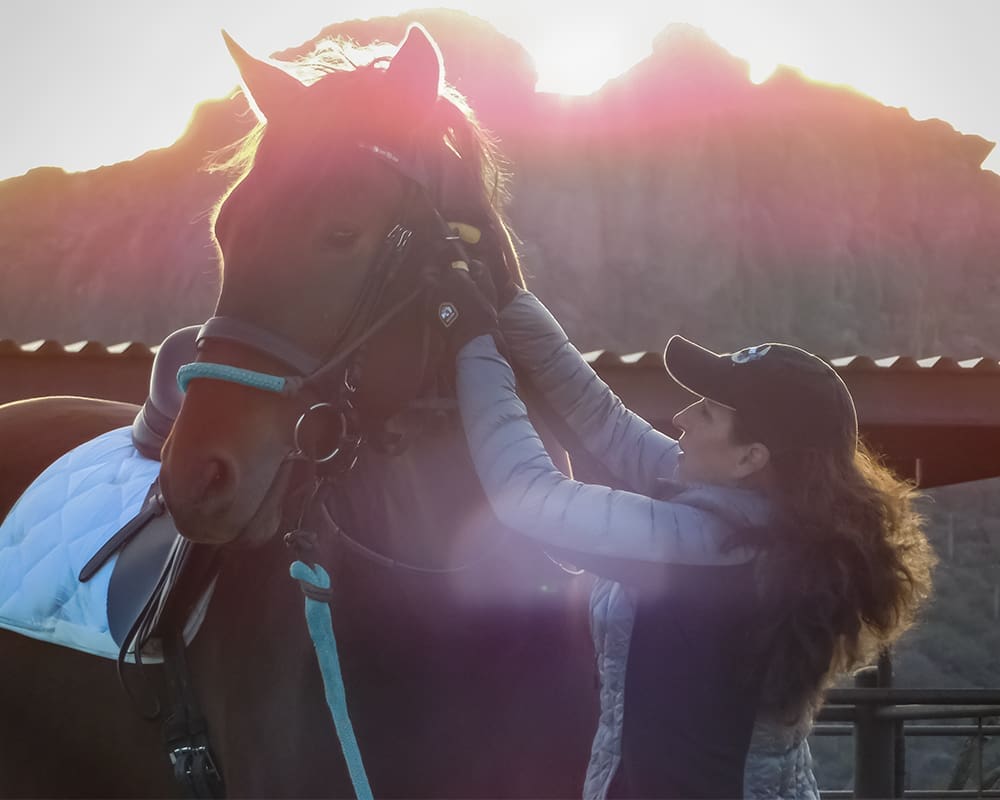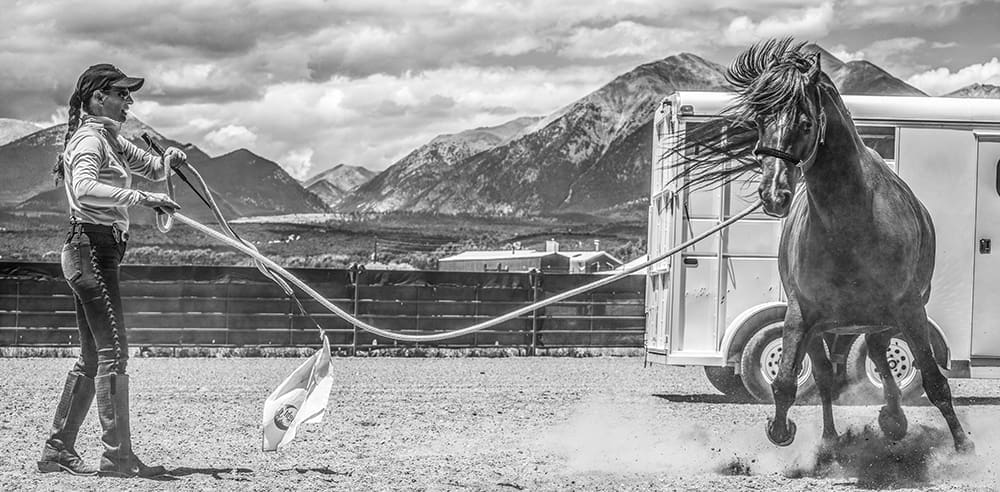
Foundational Training Under-Saddle
With solid ground-handling skills in place, half the battle of under-saddle training is behind you. As the young horse’s training progresses from ground manners to riding skills, there are certain philosophies that must be consistently applied to its training to make an exceptional trail horse. These skills are important no matter what discipline you choose, but when riding into uncontrolled and un-improved environments with natural hazards, these skills can be the difference between a fun and exciting ride and a total disaster.
Obedience: Fundamental obedience starts from day one of under-saddle training and it means that the horse will go on the exact path dictated by the rider, at the speed chosen by the rider, without argument from the horse or excessive management by the rider. This is important in all horses and especially in trail horses. I always want to be able to control the path my horse travels on the trail. If I allow him to choose the path, he may ram my knee into a tree trunk or hang me on a low branch.
Work Ethic: While this can be a natural quality in a horse, it will certainly be solidified through consistent training and handling. A good trail horse is forward moving, eager to please, and willing to work. When I ask my horse for effort, I need to see it, but I’m careful not to abuse the power by asking too much. I expect the same work ethic in my horse that I have for myself, but I always recognize his efforts and reward the horse, with rest, for a job well-done.
Rating Speed: Whether I’m leading the horse from the ground, ponying from another horse or riding the trail horse, he needs to rate his speed off of me or off another horse. No hanging back, then trotting up. No outpacing all the other horses. A horse is perfectly capable of maintaining a given speed (without you holding or pushing) and they instinctively rate speed off other horses, so it shouldn’t be hard to train. From the very beginning of a young horse’s training, proper spacing and rating speed needs to be ingrained.
Complete and Total Body Control: Often we hear people say, “he’s just a trail horse,” as if riding in a wild environment with natural hazards isn’t risky. I know the importance of having full body control on my horse, especially on the trail, where tight spots can be scary and a horse that panics and runs will get us both hurt. Being able to control the exact placement of my horse’s nose, shoulders, hip, and feet, no matter how rough the terrain is, will keep me safe and get me out of a lot of trouble. Full body control and lateral movements are not just for show horses.
Ride Alone or In Company: While all horses prefer to be in the company of other horses, I need my horse to trust me enough to go out alone—whether that be for a short jaunt away from the group or going on a long ride alone. There are two important factors here: one is that my horse is not herd-bound and the other is that my horse gets the same level of confidence from me that he gets from the herd. I want him to think of us as a team; we are in it together and reliant on each other. This does not come easily—it requires hard work, leadership, and dedication on your part.
Minds Manners Around Other Horses: I’m extremely strict about my horses’ behavior around other horses. No fraternizing in any way is allowed, when the horse is being handled or ridden. No friendly interactions, no busy-bodies, and certainly no aggression. That’s a basic manner that all horses should be taught from a young age… when you are being handled or ridden, no herd interactions are allowed! Trail horses are often ridden in groups with unknown horses. They may have to be in close proximity to other horses and perhaps even tied on a highline next to a horse they don’t know. Besides, he is at work and on-the-clock when we are trail riding; it’s not social time. This is first and foremost a safety issue that will prevent someone from getting kicked, or worse. If your horse has bad manners, in this regard, it’s a poor reflection on your horsemanship and a liability to the group.
Stands Quietly for Mounting and Dismounting: From day one, we teach horses to stand square, dead-still, and on a loose rein for mounting and dismounting and to never walk off without a cue from the rider. This will come in mighty handy should you find yourself on the side of a steep mountain, getting off and back on because someone dropped their camera. Never walking off or increasing speed without a cue, is important for when you are riding with inconsiderate riders who take off without warning.
Performs the Same Away from Home and in New Environments: The ability to perform skills in new places and in different situations, is something a horse learns over time and through varied experiences. Horses are location-specific in what they learn (they associate their behavior and actions with a place). Learning new skills at home (where the horse is relaxed) happens fast, but it takes months and years of performing those same skills in new locations before the horse is a seasoned pro. As early as possible in the horse’s training, we try to put them in new situations—teach them to investigate and be curious when they are uncertain, and take them on small journeys to increase their exposure and confidence. Horses move through the first two stages of learning fast: acquisition of skills and fluency of skills. But generalizing what he has learned—to be able to perform any time or place, even under duress—takes a lot of time and careful planning to make sure the horse always has confidence-building experiences away from home.
You may have noticed that the manners and skills necessary to make a great trail horse are the same for any good horse—safe, reliable, mannerly, and obedient—makes for a pleasant horse to be around. Even if you will never head into rugged terrain or camp overnight with your horse, developing these qualities in your horse will make him successful in whatever activity you do.
There’s no such thing as “just” a trail horse. A lot of hard work goes into finding the right prospect, developing the skills that will keep you safe on the trail, and establishing a meaningful relationship with the horse. But it is time well-spent when you and your horse need to rely on each other out in the wilderness.
There are so many important traits to develop in the making of a great trail horse. What I’ve talked about here is just the beginning. Next month, I’ll write about the importance of a trail horse accepting any position on the trail line-up—from lead, to middle, to rear, to flank. I’ll discuss whether good lead horses are born or made, and how to train your horse to accept any position and ride calmly away from the herd when asked.
Get All of Julie Goodnight’s Training Videos: HERE
Goodnight’s Guide to Great Trail Riding BOOK



